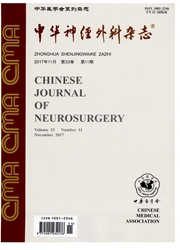

 中文摘要:
中文摘要:
目的评估磁共振氨基质子转移(APT)成像在鉴别脑单发转移瘤与高级别神经上皮肿瘤方面的应用价值。方法收集2013年3月至2014年3月南方医科大学珠江医院神经外科收治的脑单发转移瘤和高级别神经上皮肿瘤病例共83例,选取病灶的最大层面行APT序列扫描,将经手术病理证实的34例脑转移瘤(34个病灶)和49例高级别神经上皮肿瘤(49个病灶)APT图像结合常规MRI图像划分出瘤核心区和瘤旁区两个感兴趣区域,测量APT转移率(APTR)并构建伪彩图,分别比较转移瘤与高级别神经上皮肿瘤的瘤核心、瘤旁区的APTR差异。应用受试者特性曲线分析鉴别两者的最佳界值。结果伪彩图示转移瘤组与高级别神经上皮肿瘤组的瘤核心信号强度相近,但两组瘤旁区信号差异较为明显;转移瘤组与高级别神经上皮肿瘤组瘤核心区APTR分别为(2.92±0.51)%和(3.06±0.56)%,两者之间差异无统计学意义(P=0.233);转移瘤组和高级别神经上皮肿瘤组瘤旁区APTR分别为(1.47e0.23)%和(1.81±Q31)%,两者之间差异有统计学意义(P=0.000)。结论APT成像结合常规序列,特别是量化瘤旁区的APTR,对转移瘤和高级别神经上皮肿瘤的鉴别诊断有一定的临床应用价值。
 英文摘要:
英文摘要:
Objective To investigate the application value of identification of the solitary metastatic tumors and the high-grade neuroepithelial tumors with amide proton transfer (APT) magnetic resonance imaging. Methods A total of 83 patients with metastatic tumor and high-level neuroepithelial tumor admitted at the Department of Nearosurgery, Zhujiang Hospital, Southern Medical University from March 2013 to March 2014 were enrolled. The patients with metastatic tumor and high-level neuroepithelial tumor newly diagnosed by conventional magnetic resonance imaging performed AFF sequential scan. For the 34 patients with metastatic tumor (34 foci) and 49 patients with high-grade neuroepithehal tumors (49 foci) confirmed by surgery, the APT images divided the tumor core areas and two regions of interest of paratumor areas. The amide proton transfer ratio (APTR) was measured and the pseudo-color images were constructed. The AFFR differences of the tumor cores and the paratumor areas between the metastatic tumors and the high-level neuroepithelial tumors were compared respectively using two independent sample t tests. Simuhaneously, the receiver operating characteristic curve analysis was used to identify the best cut-off values of both. Results The pseudo-color images showed that the tumor core signal intensity was similar between the metastatic tumor group and the high-grade nearoepithelial tumor group, but the signal difference of the paratumor area was more obvious. The tumor core area AH'Rs in the metastatic tumor group and the high-grade neuroepithelial tumor group were (2. 92± 0. 51 )% and (3. 06± 0. 56)% respectively. There was no significant difference between the two groups ( P = 0. 233 ). The peritumoral area AFFRs in the metastatic tumor group and the high-grade neuroepithelial tumor group were ( 1.47 ± 0. 23 ) % and ( 1.81 ±0. 31 )% respectively. There was significant difference between the two groups(P = 0. 000). Conclusions APT inmging combined with conventional sequenc
 同期刊论文项目
同期刊论文项目
 同项目期刊论文
同项目期刊论文
 Quantitative characterization of nuclear overhauser enhancement and amide proton transfer effects in
Quantitative characterization of nuclear overhauser enhancement and amide proton transfer effects in Three-Dimensional Turbo-Spin-Echo Amide Proton Transfer MR Imaging at 3 Tesla and Its Application to
Three-Dimensional Turbo-Spin-Echo Amide Proton Transfer MR Imaging at 3 Tesla and Its Application to Activity-induced manganese-dependent functional MRI of the rat visual cortex following intranasal ma
Activity-induced manganese-dependent functional MRI of the rat visual cortex following intranasal ma Molecular MRI differentiation between primary central nervous system lymphomas and high-grade glioma
Molecular MRI differentiation between primary central nervous system lymphomas and high-grade glioma Saturation Power Dependence of Amide Proton Transfer Image Contrasts in Human Brain Tumors and Strok
Saturation Power Dependence of Amide Proton Transfer Image Contrasts in Human Brain Tumors and Strok 期刊信息
期刊信息
